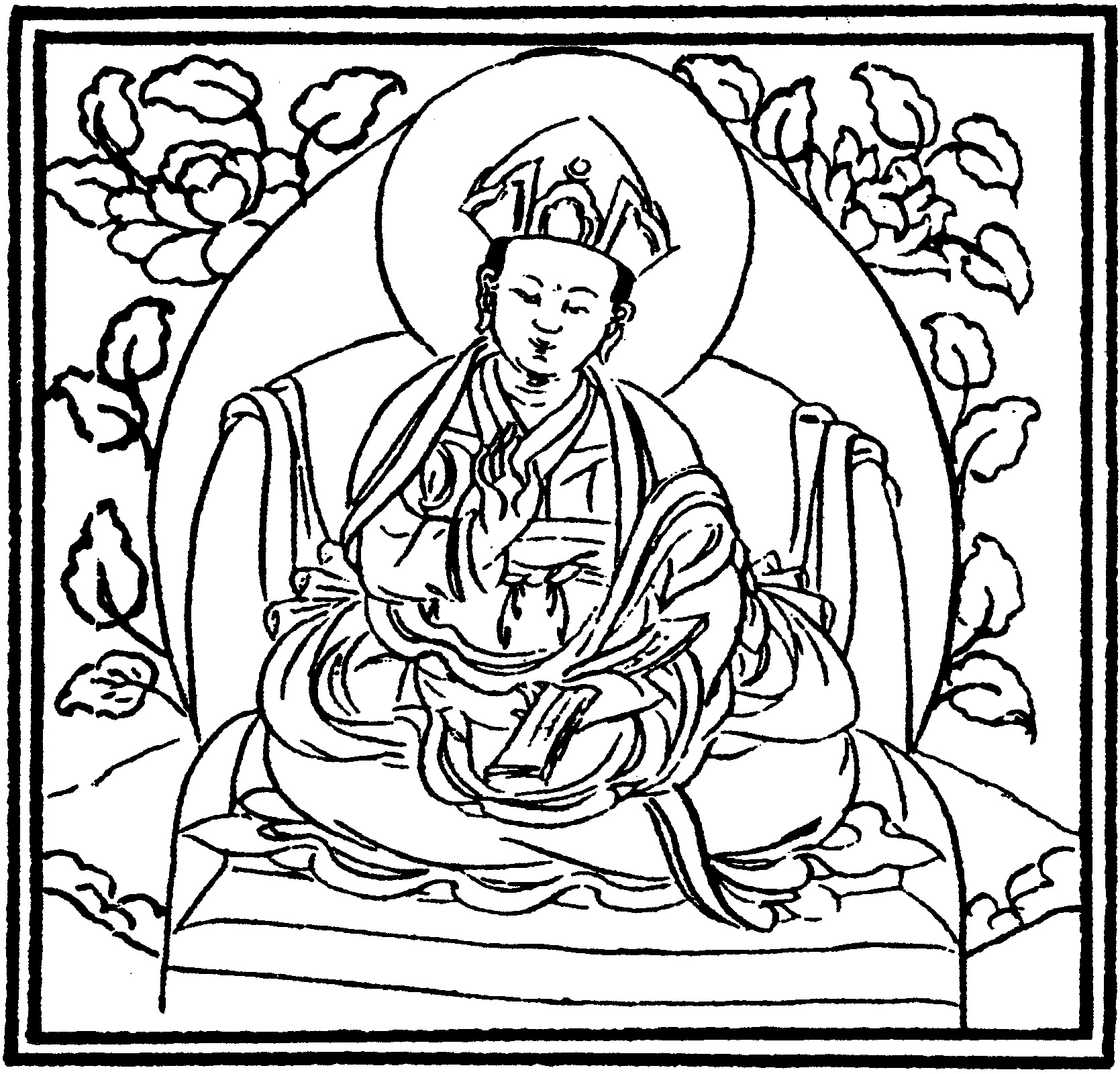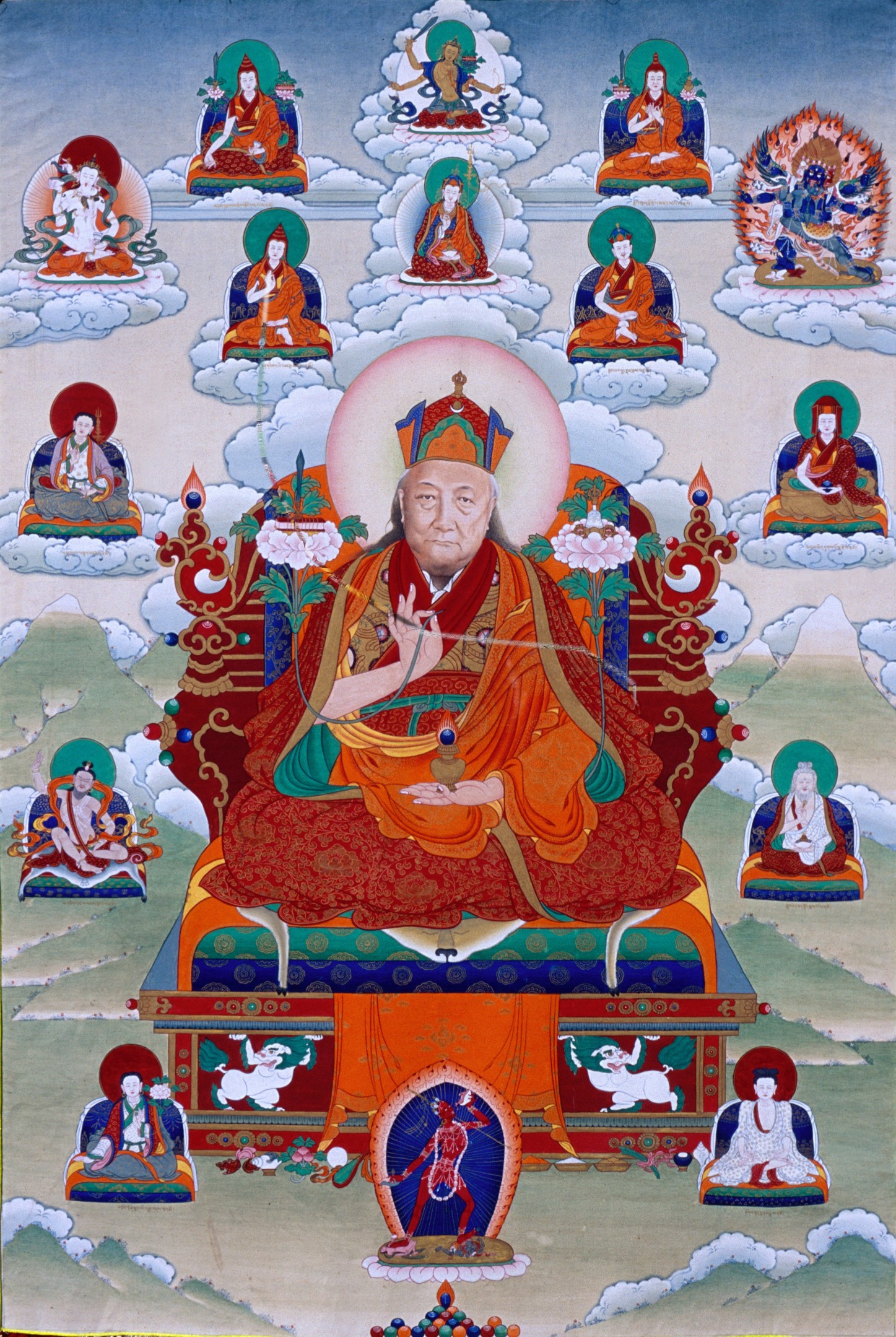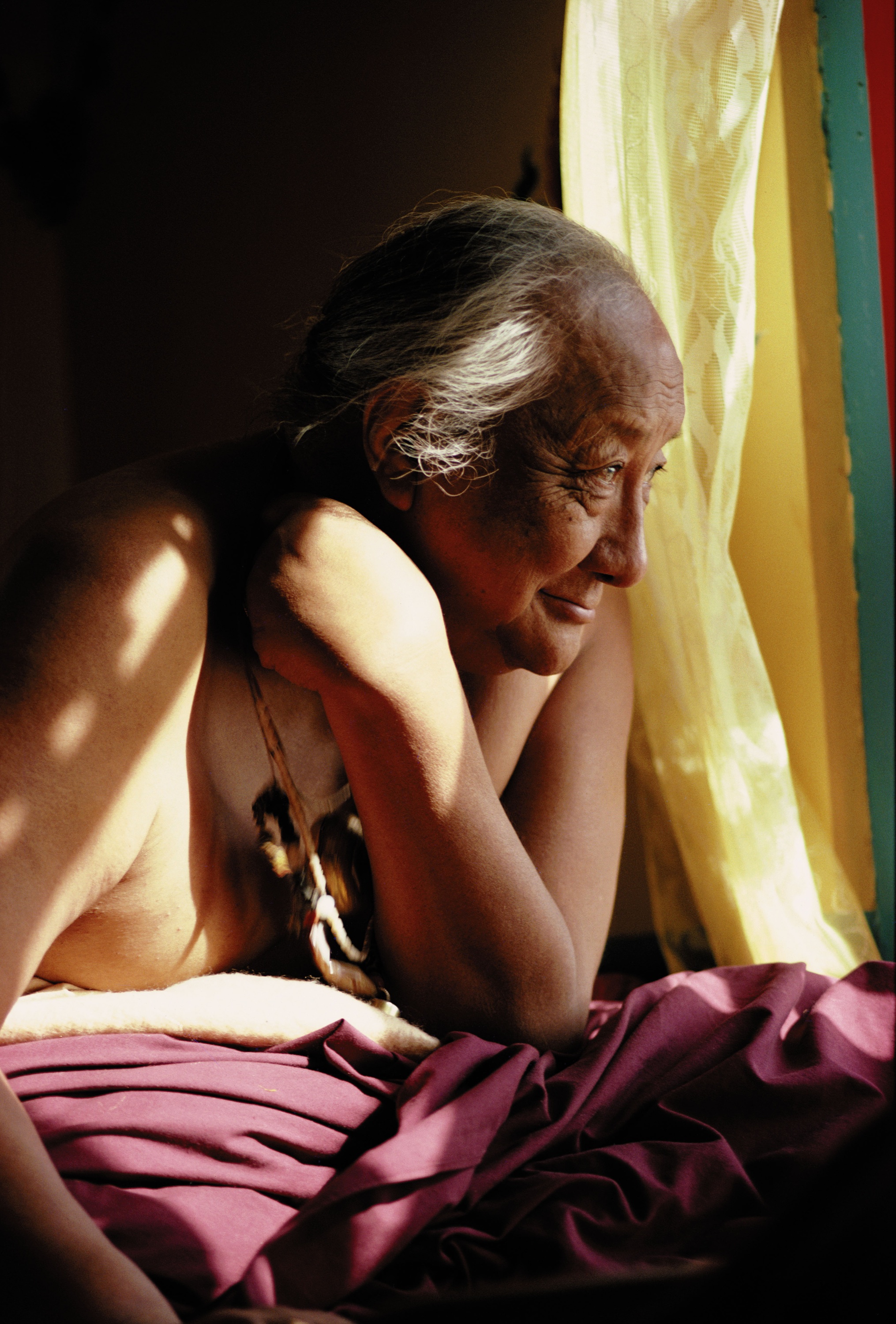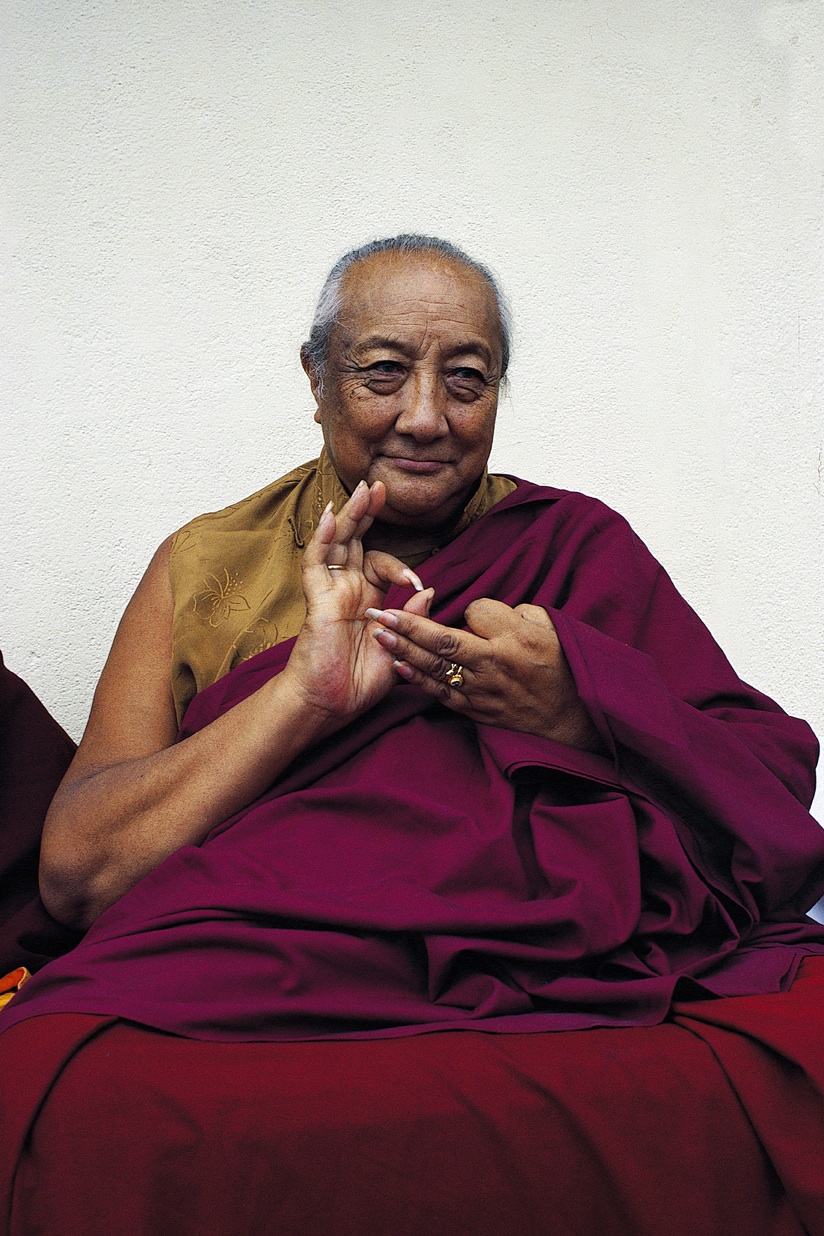Dilgo Khyentse Tashi Peljor Rinpoche
In 1912 the Fourth Shechen Gyeltsab Pema Namgyel (zhe chen rgyal tshab 04 padma rnam rgyal) visited the Dilgo family during the funeral services for Ju Mipam, and asked Tashi Tsering to give Tashi Peljor to Shechen monastery.
This request he accepted, although Tashi Peljor remained with his family for several more years. In 1916, while the Dilgo family was on pilgrimage to Tibet, the Fifth Taklung Matrul (stag lung ma sprul) told Tashi Peljor that his son was surely an incarnation, and asked whether he would make him a monk or a layman. Tashi Peljor declared that the boy would remain a layman, stressing that the family had a great deal of wealth to administer.
In 1919 Tashi Tsering brought his family to Shechen to meet with Andzom Drukpa 01 Drondul Pawo Dorje (a ‘dzom ‘brug pa ‘gro ‘dul dpa’ bo rdo rje, 1842-1924). The lama cleared obstacles for the family, encouraging Tashi Tsering to make his young son a monk. Informed that Ju Mipam had instructed Tashi Tsering to not cut Tashi Peljor’s hair until he was twenty, Andzom Drukpa nevertheless administered novice vows, cutting just a small piece of Tashi Peljor’s hair. He gave the boy the name Urgyen Khyab (o rgyan skyab). He also gave Tashi Peljor the transmission for the preliminary practices of the Longchen Nyingtik. At both Shechen and Dzogchen monastery Tashi Peljor met high lamas who gave transmissions and foretold that obstacles would arise were he not to ordain.
One evening, while playing in the kitchen of his estate with a brother, Tashi Peljor was severely burned on the left leg when he knocked over a large cauldron of boiling soup. A lama named Rigdzin Tekchog (rig ‘dzin theg mchog) performed a healing rite, which slightly eased the pain, but the boy remained bedridden for half a year. The result of the accident was that the many lamas who had previously urged Tashi Tsering to make his son a monk were given serious consideration, and Tashi Peljor himself declared that he wished to ordain. A Lama Osel, a disciple of Ju Mipam, gave the boy novice vows and cut his hair and gave him robes. But despite the insistence of several lamas that he be enthroned, Tashi Peljor continued to remain at home.
At the end of Tashi Peljor’s convalescence Khenpo Zhenga visited his family on his way to Jekundo (skye dgu mdo) where he was charged by Loter Wangpo to establish a monastic college. Considering that boy to be the reincarnation of his own master, Onpo Tenga, Khenpo Zhenga urged him to join him there. Together with his elder brother, Shedrub Tenpai Nyima, Tashi Peljor went to the great Sakya monastery in Jekundo, Kyegu Dondrub Ling (skye rgu’i don ‘grub gling) to begin his formal studies. In the fourth month of the sheep year, 1919, he took novice vows with Khenpo Zhenga, receiving the name Jigme Rabsel Dawa Kyenrab Tenpa Dargye (‘jigs med rab gsal zla ba mkhyen rab bstan pa dar rgyas). Throughout his youth he was referred to as Tulku Selga, an abbreviation of Rabsel Dawa.
 At Kyegu Dondrub Ling Tashi Peljor first studied the Bodhisattvacaryāvatāra, which Khenpo Zhenga instructed him to teach to his mother soon after. Next he studied the Madhamikavatara, beginning in 1920. At the end of the year Khenpo Zhenga moved to his hermitage, Gyawo, above Dzogchen monastery on the slopes of Trori Dorje Ziltrom (kho ri rdo rje zil khrom). Not wanting to terminate his instruction of the young Tashi Peljor, Khenpo Zhenga invited the boy to accompany him, giving him instructions in the Words of My Perfect Teacher (kun bzang bla ma’i bshad lung) and basic Madhyamaka treatises such as the Madhyamaka-karika. With his brother Shedrub, Tashi Peljor sat a one-month Vajrakila retreat at Sakar Samdrubling (sa dkar bsam ‘grub gling), in Derge, using Ju Mipam’s Rgud lugs ‘phur ba, at one point using his Kila visualization to punish a runaway servant. For the next few years he and his brother continued to receive teachings from Dzogchen monastery lamas and to sit short retreats.
At Kyegu Dondrub Ling Tashi Peljor first studied the Bodhisattvacaryāvatāra, which Khenpo Zhenga instructed him to teach to his mother soon after. Next he studied the Madhamikavatara, beginning in 1920. At the end of the year Khenpo Zhenga moved to his hermitage, Gyawo, above Dzogchen monastery on the slopes of Trori Dorje Ziltrom (kho ri rdo rje zil khrom). Not wanting to terminate his instruction of the young Tashi Peljor, Khenpo Zhenga invited the boy to accompany him, giving him instructions in the Words of My Perfect Teacher (kun bzang bla ma’i bshad lung) and basic Madhyamaka treatises such as the Madhyamaka-karika. With his brother Shedrub, Tashi Peljor sat a one-month Vajrakila retreat at Sakar Samdrubling (sa dkar bsam ‘grub gling), in Derge, using Ju Mipam’s Rgud lugs ‘phur ba, at one point using his Kila visualization to punish a runaway servant. For the next few years he and his brother continued to receive teachings from Dzogchen monastery lamas and to sit short retreats.
In the summer of 1924 Tashi Peljor, together with Shedrub and their brother Sanggye Nyenpa (sangs rgyas gnyen pa), who had just come out of three-year retreat, traveled to Shechen to meet the Fourth Shechen Gyeltsab, Padma Namgyel(zhe chen rgyal tshab 04 pad+ma rnam rgyal), who was then in retreat in a hermitage above Shechen. The aged lama gave the three brothers a series of empowerments, including Terdak Lingpa Gyurme Dorje‘s (gter bdag gling pa ‘gyur med rdo rje, 1646-1714) Mindroling Vajrasattva (smin grol gling rdo rje sems dpa’) and Guru Chowang‘s Purba Yangsang Putri (phur ba yang gsang spu gri). They also received empowerments at that time from Shechen Kongtrul Pema Drime (zhe chen kong sprul pad+ma dri med, 1901-1960), and Tashi Peljor memorized the root Guhyagarbha tantra. This was the first time Tashi Peljor engaged in serious study of the Vajrayāna. Shechen Gyeltsab also gave the three the reading transmission for Ju Mipam’s collected works, using block prints from Derge, Shechen, and elsewhere, as well as remaining manuscripts.
Leaving Shechen for a short time, Tashi Peljor went to Dzogchen and Pelpung (dpal spung) to receive additional teachings from Khenpo Zhenga and the Ninth Pelpung Situ, Pema Wangchok Gyelpo (dpal spung si tu 09 pad+ma dbang mchog rgyal po). While at Pelpung they also studied grammar and poetics with the senior chant master, Tenzin Dorje (bstan ‘dzin rdo rje).
After meeting with Pelpung Situ on the first day of the new wood mouse year, Tashi Peljor and his brother Shedrub were given leave to return to Shechen to receive Jamgon Kongtrul’s Treasury of Instructions (gdams ngag mdzod) withJamyang Khyentse Chokyi Lodro (rdzong sar mkhye brtse chos kyi blo gros, 1893-1959), who had requested it. Because Shechen Gyeltsab was at that time preparing to administer novice vows to several young disciples, Tashi Peljor requested to retake his vows with his new master, receiving the new ordination name Gyurme Labsum Gyeltsen (‘gyur med lab sum rgyal mtshan). It was an auspicious time to return to Shechen, as Gyeltsab was just them opening the new monastic college, and Tashi Peljor was able to participate in the many teachings and transmissions as part of the consecration.
During these teachings and empowerments Shechen Gyeltsab formally enthroned Tashi Peljor as a reincarnation of Jamyang Khyentse Wangpo, giving him the name Gyurme Tekchog Tenpai Gyeltsen (‘gyur med theg mchog bstan pa’i rgyal mtshan). The formal recognition seems to have deepened the warm relationship that Tashi Peljor enjoyed with Dzongsar Khyentse Chokyi Lodro.
Until his Shechen Gyeltsab passed away in 1926 Tashi Peljor never travelled far from Shechen, residing at the hermitage to be near Gyeltsab Rinpoche. He studied with numerous lamas there, including training in the Guhyagarbha with Khenchen Tubten Chopel (thub bstan chos ‘phel) using Longchenpa’s commentary Dispelling Darkness in the Ten Directions (gsang snying ‘grel pa phyogs bcu mun sel), and sat retreats putting into practice what he had been taught.
Following his master’s death Tashi Peljor went into secluded retreat, staying in a cave in Denkok with his brother Shedrub and two attendants below in a small house. Although bear occasionally harassed the residents of the house, the cave was accessible via ladder alone, so he was left unmolested, save for the presence of many birds and a small dog that met an unfortunate end, eaten by a leopard.
In the late summer of 1932 the reincarnation of Shechen Gyeltsab, Gyurme Pema Dorje (zhe chen rgyal tshab 05 ‘gyur med pad+ma rdo rje, d.u.), was enthroned as the final incarnation of the line. As part of the enthronement many of Tashi Peljor’s teachers came to Shechen and he received numerous empowerments and transmissions.
In 1934, at the age of twenty-five, Tashi Peljor suffered a severe fever that brought him close to death. Deciding that taking a consort and living the life of a tantrika would improve his health, he renounced his monastic vows and paired withKhandro Lhamo (mkha’ ‘gro lha mo), with whom he had two daughters. It is a widely held belief in Tibet that in order to reveal treasure one must practice sexual yoga, and thus the new arrangement was considered by his community to have opened the door to the possibility of revealing treasures, something he was urged to do by Chokyi Lodro and the Tenth Zurmang Trungpa, Karma Chokyi Nyingche(zur mang drung pa 10 kar+ma chos kyi nyin byed, c.1879-1939). It was a transition that Tashi Peljor made not two years after the death of his father, who had been so resistant to his becoming a monk, and yet who had been very proud of his son’s accomplishments as a cleric.
 The following year he revealed the first section of one of his most celebrated treasures, Pema’s Heart Essence of Longevity (pad+ma tshe yi snying thig) at Doti Gangkar (rdo ti gangs dkar), near Ladro Samdrub Lhaden Chokor Ling (gla gro bsam ‘grub lha ldan chos ‘khor gling) in Nangchen. The revelation was completed the following year at Lotus Crystal Cave (pad+ma shel phug), a treasure site opened by Khyentse Wangpo and Chokgyur Lingpa(mchog ‘gyur gling pa, 1829-1870) near Dzongsar.
The following year he revealed the first section of one of his most celebrated treasures, Pema’s Heart Essence of Longevity (pad+ma tshe yi snying thig) at Doti Gangkar (rdo ti gangs dkar), near Ladro Samdrub Lhaden Chokor Ling (gla gro bsam ‘grub lha ldan chos ‘khor gling) in Nangchen. The revelation was completed the following year at Lotus Crystal Cave (pad+ma shel phug), a treasure site opened by Khyentse Wangpo and Chokgyur Lingpa(mchog ‘gyur gling pa, 1829-1870) near Dzongsar.
In 1944 Tashi Peljor spent an extended period of time at Dzongsar with Khyentse Chokyi Lodro, who gave him the transmission for the Nyingma Kama and for Jamgon Kongtrul’sTreasure of Knowledge (shes bya kun khyab). They visited the sacred sites of the Mesho valley where in the nineteenth century Jamyang Khyentse Wangpo, Jamgon Kongtrul, and Chokgyur Lingpa had revealed treasure and engaged in other rituals. Tashi Peljor performed feast offerings and decoded treasures the three earlier masters are said to have revealed. At the start of the wood bird year, 1945, Khyentse Chokyi Lodro gave him and one hundred other lamas the transmission and empowerments for the Rinchen Terdzod (rin chen gter mdzod), the collection of revealed treasures compiled by Jamgon Kongtrul.
The next year Tashi Peljor traveled around Kham, visiting sacred sites of Chokgyur Lingpa’s treasure revelations and monasteries. In Nangchen he met the holders of Chokgyur Lingpa’s lineage, including Terse Tulku Gyurme Tsewang Tenpel (‘gyur med tshe dbang bstan ‘phel, d.u.), the reincarnation of Chokgyur Linga’s sonWangchuk Dorje (dbang byug rdo rje, d.u.). He also met the two reincarnations, Tsike Chogling Konchok Gyurme Tenpai Gyeltsen (rtsi ke mchog gling dkon mchog ‘gyur med bstan pa’i rgyal mtshan, 1871-1939) there; he had befriended the Neten Chogling Ngedon Drubje Dorje (gnas brtan mchog gling nge don grub rje rdo rje, c.1873-1927) during the Rinchen Terdzod transmission at Dzongsar the year before. Examining the treasure objects of Chokgyur Lingpa, Tashi Peljor found and decoded a sheet of ḍākinī script, producing a treasure cycle of theKabgye (bka’ brgyad).
In the early years of the Communist occupation of Kham Tashi Peljor continued his religious activity. He traveled to Nangchen, giving and receiving teachings at Zurmang Dutsitil (zur mang bdud rtsi mthil), Trangu (khra ‘gu dgon pa) and other monasteries in the region. In Derge he performed rites for the wellbeing of the Derge Kingdom. He stayed at Rebkong (reb kong) for a year, where he gave the transmission for the Rinchen Terdzod and opened a sacred place at Amye Machen (a myes rma chen). Back in Dzongsar, Tashi Peljor received teachings from Sakya Gongma, who was then traveling to China. Sakya Gongma (sa skya dgong ma) resided at Dzongsar for about a year with his wife and small children, giving teachings to increasingly large crowds. Tashi Peljor gave him a long-life empowerment from one of his treasures.
During a short trip to Nangchen Tashi Peljor revealed a major treasure cycle, Nyak Kilaya (gnyag lugs phur ba) at Karmagon, returning to Sakar to decode it. He went to Dzongsar to show it to Khyentse Chokyi Lodro and while there he wrote liturgies for the sadhana, daily practice, exorcism, and empowerment.
Soon after, in 1956, when Tashi Peljor was forty-six, he left Kham for Lhasa. While staying at Khampa Gar (khams pa sgar) in Nangchen Chinese soldiers had come to Sakar looking for him. For several weeks his wife delayed them, telling them Tashi Peljor had gone to one place or the other and sending messengers after him. Finally she decided it was no longer safe for her to remain, and, taking only a bag of tsampa to allay suspicion, she went to Tashi Peljor and they made plans to travel immediately to Lhasa, interrupting teachings he was giving with the Eighth Khamtrul Tulku, Dongyud Nyima (khams sprul sprul sku 08, don brgyud nyi ma, 1930-1979).
Khyentse Chokyi Lodro had already left for Sikkim and Tashi Peljor used his ostensible pilgrimage as a staging for his own escape into exile. He remained in Lhasa for several years, until the situation there became critical. In Lhasa, in 1956 he gave four months of Guhyagarbha teachings; at Tsurpu he gave the transmission for the complete treasures of Chokgyur Lingpa.
Around that time his brother Shedrub passed away. He also visited Mindroling for a month, and, in Lhasa he met Dudjom Jikdrel Yeshe Dorje (bdud ‘joms ‘jigs bral ye shes rdo rje, 1904-1988) for the first time. He also encountered the Fourteenth Dalai Lama while performing a feast offering in the Jokang (jo khang), later formally meeting him in Norbulingka (nor bu gling ka) with Sakya Gongma. At that meeting he was too shy to remain in the room, but soon after he returned for an audience with his brother Sanggye Nyenpa. The Dalai Lama asked Sanggye Nyenpa whether his monastery had been destroyed, and Sanggye Nyenpa replied that it had.
 Not long after the Dalai Lama and the Karmapa fled, Tashi Peljor and his family also left Tibet, as the Chinese were increasingly threatening high lamas from Kham with forced return. They fled with other families and members of the Khampa guerilla fighters to Bhutan, via the Drula and Dora passes. For twelve days they were detained on the border until the government permitted their entrance to the country. Staying only a few weeks in Bhutan, relying on the charity of the local people in the villages he passed through, he continued to Kalimpong, India, where he stayed with Dudjom Jikdrel Yeshe Dorje.
Not long after the Dalai Lama and the Karmapa fled, Tashi Peljor and his family also left Tibet, as the Chinese were increasingly threatening high lamas from Kham with forced return. They fled with other families and members of the Khampa guerilla fighters to Bhutan, via the Drula and Dora passes. For twelve days they were detained on the border until the government permitted their entrance to the country. Staying only a few weeks in Bhutan, relying on the charity of the local people in the villages he passed through, he continued to Kalimpong, India, where he stayed with Dudjom Jikdrel Yeshe Dorje.
Tashi Peljor remained in Kalimpong for several years, shifting occasionally to Bhutan and Sikkim to visit the remains of Khyentse Chokyi Lodro, who passed away there in 1959, and to give the transmission and empowerments for theRinchen Terdzod to his reincarnation. In 1961 he was invited to Bhutan to serve as the head of the monastic college in Timphu, remaining there until the winter of 1962, when he received the unhappy news that his brother had passed away in Sikkim, and he learned that his youngest daughter was ill. Dechen Wangmo (bde chen dbang mo) died in Lucknow, in early 1963. In 1965 Gelong Pema Dorje of Nyimalung monastery in Bumthang invited Tashi Peljor to Bhutan. He arrived in the wake of serious civil strife, and began his activity with pacification rites. He soon was given a Bhutanese passport, and Bhutan became his main residence for the remainder of his life.
One evening Tashi Peljor received a dream in which Shechen Rabjam, Shechen Kongtrul, and Shechen Gyeltsab, who had all been murdered by the Chinese Communists, all appeared. They told Tashi Peljor that they would all three incarnate into one person, setting the stage for him to recognize his grandson, Jigme Chokyi Sengge, born to his daughter Chime Wangmo, as the incarnation of three of his own teachers; he was given the title of the Seventh Shechen Rabjam (zhe chen rab ‘byams 7 ‘jigs med chos kyi seng+ge, b. 1966).
For the next three decades Tashi Peljor dedicated himself to preserving the Nyingma tradition, traveling across Bhutan, India, and Nepal to give teachings, transmissions, and empowerments.
Tashi Peljor first visited the West in 1975. He made three trips to North America and numerous visits to Europe, especially to France, where he established a three year retreat center in the Dordogne region.
In 1980 Tashi Peljor built Shechen Tenyi Dargyeling (zhe chen bstan gnyis dar rgyas gling) in Boudhanath, Nepal, which became the principle seat of Shechen outside of Kham. It is led by Shechen Rabjam, and is a center of publishing of Nyingma scripture.
 In 1985 Tashi Peljor traveled to Tibet as part of an official Bhutanese delegation. In Lhasa he presided over the consecration of a new statue of Padmasambhava in the Jokang. He was able to visit Shechen and Dzogchen, which were being rebuilt. During a second trip, in 1988, he stayed at Shechen for some time and was able to give public teachings, reopening the monastic college there. In Derge he reconsecrated the printing house. He also visited Dzongsar and gave public teachings there as well, having to be carried over two passes on a pelanquin via Pelpung. He was able to also visit Payul and Katok as well. During his third trip, in 1990, he presided over the reconsecration of Samye (bsam yas). Overall, as soon as Tibetans were allowed to rebuild their religious institutions, Tashi Peljor was involved in the reconstruction and reconsecration, and the training of the monks, personally funding an enormous amount of the work and offering his guidance wherever he could.
In 1985 Tashi Peljor traveled to Tibet as part of an official Bhutanese delegation. In Lhasa he presided over the consecration of a new statue of Padmasambhava in the Jokang. He was able to visit Shechen and Dzogchen, which were being rebuilt. During a second trip, in 1988, he stayed at Shechen for some time and was able to give public teachings, reopening the monastic college there. In Derge he reconsecrated the printing house. He also visited Dzongsar and gave public teachings there as well, having to be carried over two passes on a pelanquin via Pelpung. He was able to also visit Payul and Katok as well. During his third trip, in 1990, he presided over the reconsecration of Samye (bsam yas). Overall, as soon as Tibetans were allowed to rebuild their religious institutions, Tashi Peljor was involved in the reconstruction and reconsecration, and the training of the monks, personally funding an enormous amount of the work and offering his guidance wherever he could.
Even in the last years of his life, Tashi Peljor’s extraordinary energy and vigor were little affected by his advancing age. He passed away on September 27, 1991, in Bhutan. His main lineage holders are his grandson Shechen Rabjam, and many other lamas who spent years receiving teachings and empowerments from him. His reincarnation, Dilgo Yangsi, was born on June 30, 1993, the son of Tsike Chogling Mingyur Dewai Dorje (rtsi ke mchog gling mi ‘gyur bde ba’i rdo rje, b.1953) and the grandson of Tulku Orgyen Tsewang Chokdrub Pelbar (sprul sku o rgyan tshe dbang mchog grub dpal ‘bar, 1910-1996), and enthroned at Shechen in December 1997.
Alexander Gardner is Executive Director of the Shelley & Donald Rubin Foundation and the Director and Chief Editor of the Treasury of Lives. He completed his PhD in Buddhist Studies at the University of Michigan in 2007.
Source; The Treasury of lives
Leave a Reply